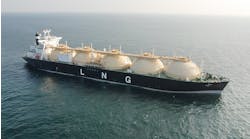Dutch authorities scale down platform scrapping expectations
Government and port authorities in The Netherlands are revising their view of the offshore dismantling market following the failed attempt of a local industrial alliance to establish a dedicated breakdown yard for offshore platforms.
After completing the scrapping of BHP's UK southern gas basin Esmond and Gordon platforms in 1996, no new contracts have been won by the yard. A contract for the disassembly of Wintershall's K13-B and K10-C gas production platforms in the Dutch sector was lost to Britain's Swan Hunter earlier this year.
The failure to win further dismantling work attracted public attention in The Netherlands, probably resulting also from the Brent Spar debate. It now seems that the market has been overestimated both with regard to quantity and regularity of work. "We were warning the industry of disappointments some years ago," says a Dutch offshore operator spokesman. "The offshore dismantling market seemed to be booming, but it was not."
Brent Spar's disposal problems created a totally false picture of the market, the spokesman adds. "Everybody thought that a large number of very complex platforms would have to be dismantled and that this could only be done at specialist yards.
"Esmond and Gordon proved the opposite. Platform sizes in the southern North Sea cannot be compared to those in the central and northern North Sea and moreover, most of the southern sector installations are gas platforms which do not contain large quantities of toxic materials."
Dismantling offshore platforms started in Rotterdam in 1987 when Wintershall removed its first platforms from block K13. "This work and the dismantling of Esmond and Gordon was like scrapping old ships," says the spokesman. Now the yard in Rotterdam harbor will indeed consider the option of becoming a conventional scrap site which can also handle occasional offshore platforms.
This yard is an alliance of three local companies - the metal processing company Curef, crane vessel operator Hapo International and AVR, which has one of the world's most advanced waste processing plants adjacent to the breakdown yard in the Laurenshaven.
Another Dutch alliance, ROS in Amsterdam, has so far bid unsuccessfully for platform demolition jobs. This alliance includes companies such as Wijsmuller and the DNS-Vos group.
Both the Rotterdam and Amsterdam alliances are supported by their respective local harbor authorities which are eager to attract new industrial activities. But in a recent study, the Rotterdam Port Authority acknowledged that the expectations of the offshore dismantling market were too optimistic.
It concluded that rather than a few hundred, only tens of platforms will be dismantled in the next five years. The economic life of many offshore installations has also been prolonged through enhanced production techniques and new infrastructure solutions, says the study.
In the Dutch parliament questions have been asked about state support to offshore dismantling yards but the Minister of Economic Affairs, Hans Wijers, has rejected such calls. "Despite the fact that it is not economic to establish dedicated offshore breakdown yards," he said, "due to the limited number of platforms on offer, it is clear that the activity of dismantling such platforms itself remains economic. This is demonstrated by the progress to establish such yards in Amsterdam and Rotterdam."
This summer, contractors were invited to bid for NAM's platform removal program. During the next 25 years only 20 small and medium-sized shallow-water gas installations have to be removed. At a rate of less than one removal per year, this can hardly form the economic basis for a dedicated platform break-up yard.
Lift-off
More successful in the decommissioning sector have been Dutch engineering and heavy lift companies. In June, Seaway Heavy Lifting removed Wintershall's K13-B and K10-C decks from their jackets, transporting them to Tyneside for dismantling.HeereMac and Seaway Heavy Lifting engineers have formulated plans for the dismantling of Phillips Maureen Alpha production platform, which the oil company is currently offering intact for re-use. Even if it is sold, says a spokesman, "the buyer will want to know what it can do with the platform after its economic life is completed". Phillips claims that Maureen Alpha, with its gravity-based storage structure, could function in production mode for another decade.
Copyright 1997 Oil & Gas Journal. All Rights Reserved.


